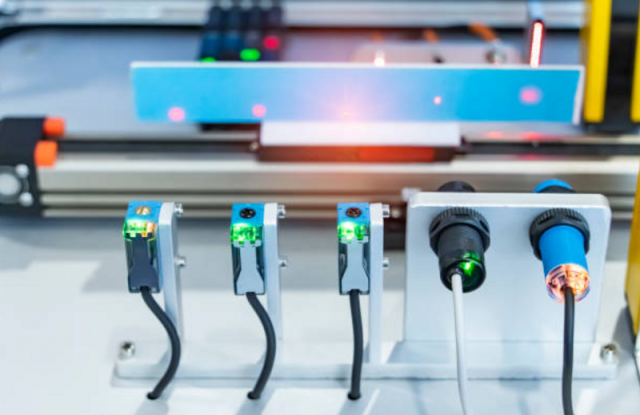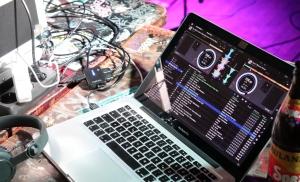Manufacturing floors today run on a mix of software smarts and hardware guts. In that mix, photoelectric sensors keep showing up because they can spot things without ever having to touch them. The diffuse version is especially popular. Its tiny size and one-cable hookup let engineers bolt it on fast and move to the next job.
This post digs into the guts of a diffuse photoelectric sensor, lists the perks that keep plant managers sold on them, and outlines why they've become a staple in the latest wave of factory gadgets. For any B2B outfit chasing shorter stops, tighter control, and higher output, knowing these gadgets inside and out is no longer optional.
What Is a Diffuse Photoelectric Sensor?
A diffuse photoelectric sensor acts like a flashlight that knows when something steps in front of it. Inside a single casing, the gadget packs both the light source and the eye that sees the light. Light beams flash out, bounce off whatever is nearby, and then slip back to the sensor's receiver. If that returning beam is bright enough, a quiet electronic cheer goes off and a signal is sent up the line.
Key Characteristics:
- Self-contained: Everything you need is built into one unit.
- Short-to-medium range: Works best when the target is 4 inches to about 6 feet away.
- Versatile: Picks up on cardboard, shiny metal, crumpled plastic-you name it.
- Non-contact detection: No moving parts to grind or get dirty.
Manufacturers love them for tight assembly lines where parts zip by and the timing has to be spot-on.
How It Works: The Principles Behind Diffuse Photoelectric Sensing
Diffuse photoelectric sensing relies on simple light-and-shadows science. The steps unfold like this:
- Emission: A narrow light beam shoots out toward the object, almost like a laser pen but softer.
How Diffuse Photoelectric Sensors Work
Reflection
Imagine standing in a spotlight on a clear night. When something walks into the beam, a chunk of that light bounces back just like a car headlight flashing off your sunglasses.
Detection
Inside the sensor, a little photo-receiver quietly watches for that returning flash. When the beam returns, the receiver gives a quick nod that something is there. No weird math required- it just says, Yup, light.
Signal Output
Once the bounce reaches a number higher than its quitting point, the sensor shouts out a signal that shrieks, Move Part Here!
Limitations
Shiny black boxes or paper-thin plates can play tricks by soaking up too much light. For those picky cases, a sensor with background tricks or tweakable guts will save the day.
Why It Matters
Pulling reflectors and fiddly brackets off the system cuts setup grind by an hour or more. Because of that, factory crews now call diffuse photo eyes the plug it and forget it of modern plants.
Benefits of Using Diffuse Photoelectric Sensors in Factory Settings
Shoving a diffuse sensor into your line can clear away headaches in a hurry, especially when downtime feels heavier than lead.
- Ease of Installation
The emitter-and-eye combo lives inside the same housing, so the beam can hit and run without kissing any mirror. Installers bolt it on, shoot once, and move to the next job without cursing a crooked line.
- Compact and Cost-Effective
Diffuse sensors are small enough to slip into tight spots, yet they rarely break the budget. You'll see them lining electrical assembly benches, clamped to packaging arms, or bolted onto the side of a factory robot.
- Non-Contact Operation
Because the sensor never actually touches the item, there's no chance of scratching or bending it. That contact-free approach also lets the unit keep working in clean rooms or other delicate setups.
- Reliable Detection
Dust, vibration, and a bit of humidity can mess with plenty of gear, yet these sensors keep firing as long as their lenses get wiped now and then. The dependability cuts down on troubleshooting headaches.
- Wide Detection Capability
One minute the beam is spotting a box sliding down a conveyor; the next it's checking whether a part is flipped the right way in a load station. The same sensor tackles both jobs without needing a complicated retune.
Getting these units on the line is, plain and simple, a way for manufacturers to plug in innovative automation products for factories that smooth out day-to-day operations and let production numbers climb.
Industrial Applications: Where Diffuse Photoelectric Sensors Excel
Robotics teams, bulk conveyors, inspection rigs-everything seems to find room for a diffuse photoeye. Their built-in versatility means the same part can read a label, count a refill, or confirm that a workpiece is home. That broad playbook is why so many industries trust them to help lines run without constant babysitting.
Common Applications
- Packaging Lines: A diffuse sensor spots a box or bottle cruising by on the belt, letting downstream equipment know it can keep moving.
- Automated Assembly: Before the next tool descends, the sensor double-checks that a tiny gear is sitting exactly where it should.
- Food Processing: Even when trays are shrink-wrapped, the light beam bounces off and confirms that every stack is present and accounted for.
- Textile Manufacturing: As sheets of cloth slide past the cutter, the sensor tracks their edge, preventing a mis-cut that wastes material.
- Pharmaceutical Lines: The sensor peers through a blister pack or glances at a bottle label, verifying that the right medication is in the right spot.
Because diffuse sensors read off shiny or light-colored surfaces with ease, they shine in factories where products aren�t all made from metal or are oddly shaped. Their lightning-fast response means machines can run at full tilt without pauses, so the whole line stays synced.
In robotic arms, a compact diffuse unit decides whether a part is really there before the gripper closes, avoiding costly mistakes when the orientation is just a degree off.
Choosing the Right Supplier for Lasting Growth
Bringing smart sensors into your plant isn't a one-off purchase; it's a step that demands a steady supply chain you can lean on over time. A supplier you can trust will:
- Chat with you up front to figure out exactly which sensor matches your application, no cookie-cutter advice
- Stock everything from proximity sensors to temperature probes plus the brackets and cables that fit them
- Keep the shelves full so you get parts shipped the same week, not months later
- Meet the big international safety and quality marks, so you're covered at home and abroad
- Pick up the phone afterward to walk you through calibration, repair, or quick replacement
Many shop floor managers lean toward a specialist in industrial automation rather than a generalist distributor. One vendor that carries diffuse photoelectric eyes, PLCs, power supplies, pneumatic valves, and even the newest IoT gateways makes life a lot simpler. Having all those pieces under one roof cuts down on paperwork, speeds up wiring, and lays the groundwork for whatever next-generation system you dream up tomorrow.
Final Thoughts
A diffuse photoelectric sensor often gets called just a light eye, yet it quietly fuels smarter, faster, and leaner manufacturing lines. People like it because you wire it up, trust it, and forget the fuss-simple design meets stubborn reliability.
Step it up and the same sensor watches for missing parts, nudges a robot into motion, or double-checks that each widget leaves the station looking right. Stack that kind of peace of mind with gear from a supplier who backs their word, and you're not just buying hardware-you're stepping into a bigger upgrade.
Factory floors are already cramped with tech, and the next wave will need smaller, brainier, thriftier sensors to squeeze out every last ounce of efficiency. Firms serious about staying ahead will grab a top-grade diffuse light unit, link up with a maker of cutting-edge automation solutions and call it a smart bet that keeps paying off well into the future.






